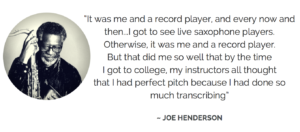[vc_row][vc_column width=”2/3″ css=”.vc_custom_1461585051858{background-color: #ffffff !important;}”][vc_column_text]One of the signs of a great sound engineer is the ability to intuitively ‘feel’ their way through a mix. You don’t have to be born with this talent. It is one that can be acquired with deliberate practice, focus and a few tools. Here’s what it takes to mix in a way that makes you an unforgettable sound engineer.[/vc_column_text][vc_row_inner][vc_column_inner width=”1/2″][vc_column_text css=”.vc_custom_1475903083777{padding-top: 10px !important;padding-right: 10px !important;padding-bottom: 10px !important;padding-left: 10px !important;background-color: #ffffff !important;}”]
Train your ears
Just like a marathon runner, who began with those short runs and followed it up with rigorous training, your ears need to be trained to catch nuances in sound. Being able to hear what is going on when it comes to different frequency bands is what makes a great mix engineer.[/vc_column_text][/vc_column_inner][vc_column_inner width=”1/2″][vc_single_image image=”1004″ img_size=”full” alignment=”center”][/vc_column_inner][/vc_row_inner][vc_column_text css=”.vc_custom_1475903125194{padding-top: 10px !important;padding-right: 10px !important;padding-bottom: 10px !important;padding-left: 10px !important;background-color: #ffffff !important;}”]These are the building blocks that will help you grasp the language of sound. Training your ears to have a laser focus will help you grasp details, such as how much reverb was used on a track you’re listening to. This requires you to be able to block out all other parts of the mix and focus on this one aspect. Blocking out all that doesn’t need to be heard for that which you want to hear is a key skill to learn.[/vc_column_text][vc_row_inner][vc_column_inner width=”1/2″][vc_single_image image=”637″ img_size=”full” alignment=”center”][/vc_column_inner][vc_column_inner width=”1/2″][vc_column_text css=”.vc_custom_1475903502489{padding-top: 10px !important;padding-right: 10px !important;padding-bottom: 10px !important;padding-left: 10px !important;background-color: #ffffff !important;}”]
Practice, practice, practice
Gaining experience through comparisons can be useful. A great exercise would be to load a favourite tune in a DAW and pick up a parametric equalizer. Then experiment with each frequency to see what changes they bring about when you cut, boost or control the Q.[/vc_column_text][/vc_column_inner][/vc_row_inner][vc_column_text css=”.vc_custom_1475903552545{padding-top: 10px !important;padding-right: 10px !important;padding-bottom: 10px !important;padding-left: 10px !important;background-color: #ffffff !important;}”]Also choose a few albums that sounds really good in your opinion and use them consistently as a barometer to help get a perspective while mixing. Though the exercise might seem discouraging at first because your reference albums are on a whole other level in comparison to your mixes, you will soon see your skills rapidly improve. Another tip is to pull up an old session you haven’t heard in a while, remix it and compare it to your old mix and notice where you see improvements.[/vc_column_text][vc_row_inner][vc_column_inner][vc_column_text css=”.vc_custom_1475903615967{padding-top: 10px !important;padding-right: 10px !important;padding-bottom: 10px !important;padding-left: 10px !important;background-color: #ffffff !important;}”]
Sound Textures Are Crucial
Producing your own elements (presets) or experimenting with someone else’s presets with a clear goal is the best way to learn textures. Your ears get trained faster this way rather than if you were to just use pre-made presets and alter their placement in the mix.[/vc_column_text][/vc_column_inner][/vc_row_inner][vc_row_inner][vc_column_inner width=”1/2″][vc_single_image image=”1006″ img_size=”full” alignment=”center”][/vc_column_inner][vc_column_inner width=”1/2″][vc_column_text css=”.vc_custom_1475905533332{padding-top: 10px !important;padding-right: 10px !important;padding-bottom: 10px !important;padding-left: 10px !important;background-color: #ffffff !important;}”]
Use visual aids
If you aren’t sure of your listening environment, whether it is the speakers, the room itself or even your ears, you can turn to a spectrum analyzer to see what’s happening in your mix.[/vc_column_text][/vc_column_inner][/vc_row_inner][vc_column_text css=”.vc_custom_1475905548386{padding-top: 10px !important;padding-right: 10px !important;padding-bottom: 10px !important;padding-left: 10px !important;background-color: #ffffff !important;}”]It gives you a reference point of what waveforms (proportions) to aim for when used with your favourite tracks. While Logic and Live have built-in spectrum analyzers in their native equalizers, you can get FabFilter Pro-Q 2 or other visualizing plugins if your DAW doesn’t have one.[/vc_column_text][vc_row_inner][vc_column_inner width=”1/2″][vc_column_text css=”.vc_custom_1475905901460{padding-top: 10px !important;padding-right: 10px !important;padding-bottom: 10px !important;padding-left: 10px !important;background-color: #ffffff !important;}”]
Listen to your mix through many different systems
Since your listening environment determines a lot of what you hear, it is a good practice to listen to your mix in different rooms and with various types of speakers.[/vc_column_text][/vc_column_inner][vc_column_inner width=”1/2″][vc_single_image image=”1008″ img_size=”full” alignment=”center”][/vc_column_inner][/vc_row_inner][vc_column_text css=”.vc_custom_1475905918284{padding-top: 10px !important;padding-right: 10px !important;padding-bottom: 10px !important;padding-left: 10px !important;background-color: #ffffff !important;}”]From hi-fi stereo systems and your car to earbuds, find a balance where your mix sounds good everywhere. There will always be limitations to each system but you can then use reference tracks to understand how a system would sound. Undoubtedly, it’s a great tool for those who are starting out.[/vc_column_text][vc_row_inner][vc_column_inner][vc_column_text css=”.vc_custom_1475904588198{padding-top: 10px !important;padding-right: 10px !important;padding-bottom: 10px !important;padding-left: 10px !important;background-color: #ffffff !important;}”]
Using ear training software and apps
There are a host of ear training drills available, whether plugins, apps or software to train your ears and improve your music mixing and mastering skills. From intensive practice in rhythm and harmonics to understanding equalisers and frequencies, these tools give you the type of deliberate practice that can improve your craft— your ears and your critical listening skills.[/vc_column_text][vc_column_text css=”.vc_custom_1475904611544{padding-top: 10px !important;padding-right: 10px !important;padding-bottom: 10px !important;padding-left: 10px !important;background-color: #ffffff !important;}”]There are many options including Golden Ears, Auricula’s Improve Your Listening Skills, Studio Ears and Quiztones.[/vc_column_text][/vc_column_inner][/vc_row_inner][vc_column_text css=”.vc_custom_1489379536947{padding-top: 10px !important;padding-right: 10px !important;padding-bottom: 10px !important;padding-left: 10px !important;background-color: #ffffff !important;}”]
BONUS TIP
Remember to Keep Your Ears Fresh
Your ears are crucial in keeping your mixes crisp so it is a good idea to prevent ear fatigue. Take care not to exceed your auditory limit and also restrict the number of times you listen to a track during a session. Another good way to keep your ears responsive is to expose them to different frequencies, sounds, textures, tones and colors. Taking an audiometry regularly to check your hearing is also recommended.
 Becoming a master sound mixer comes with consistent application, trial and error and building that focus muscle. So open your DAW and get started![/vc_column_text][/vc_column][vc_column width=”1/3″][vc_empty_space height=”500px”][vc_custom_heading text=”Contact Audio Academy” font_container=”tag:h4|text_align:left|color:%23ffffff” use_theme_fonts=”yes”][/vc_column][/vc_row]
Becoming a master sound mixer comes with consistent application, trial and error and building that focus muscle. So open your DAW and get started![/vc_column_text][/vc_column][vc_column width=”1/3″][vc_empty_space height=”500px”][vc_custom_heading text=”Contact Audio Academy” font_container=”tag:h4|text_align:left|color:%23ffffff” use_theme_fonts=”yes”][/vc_column][/vc_row]

